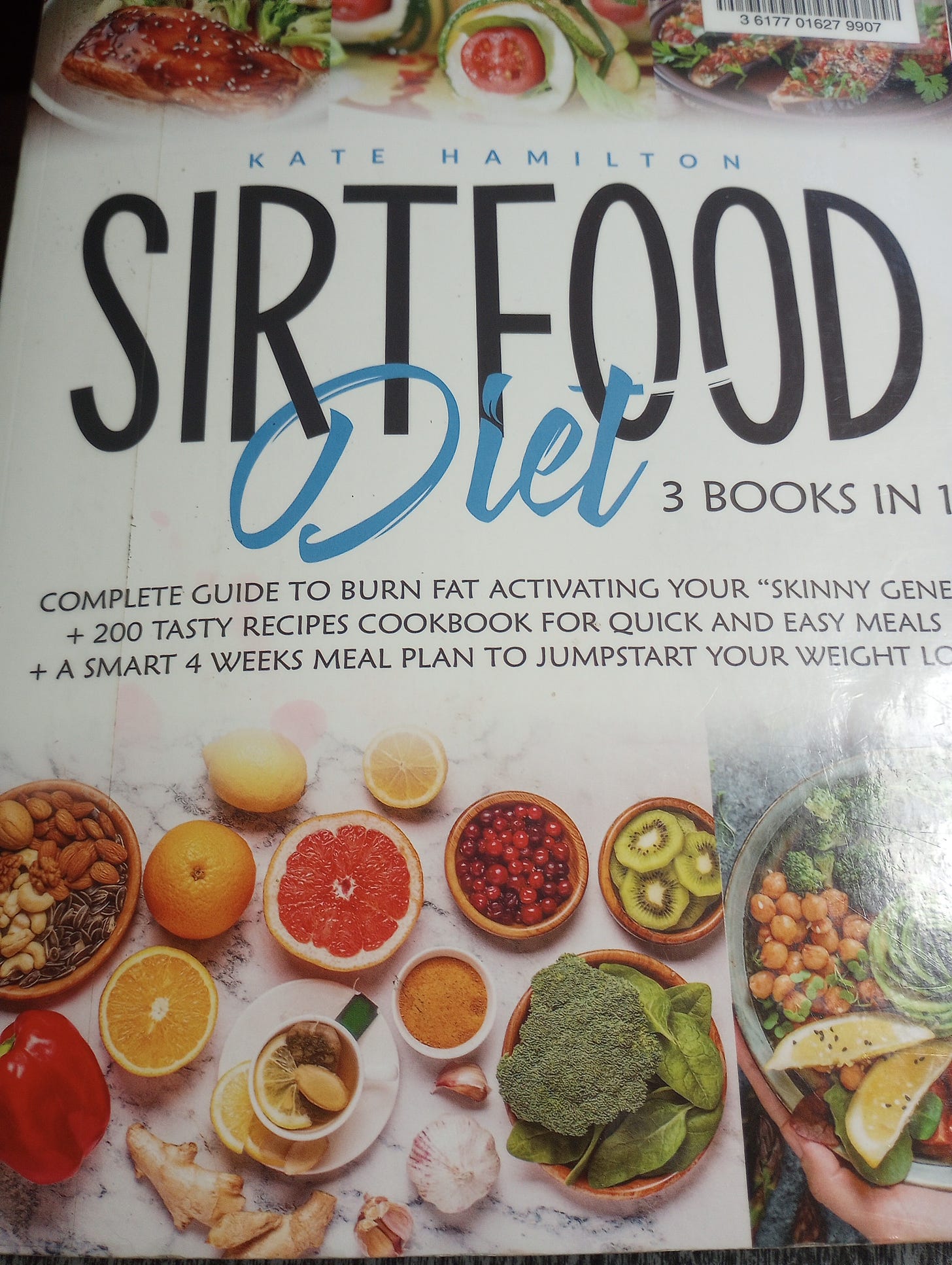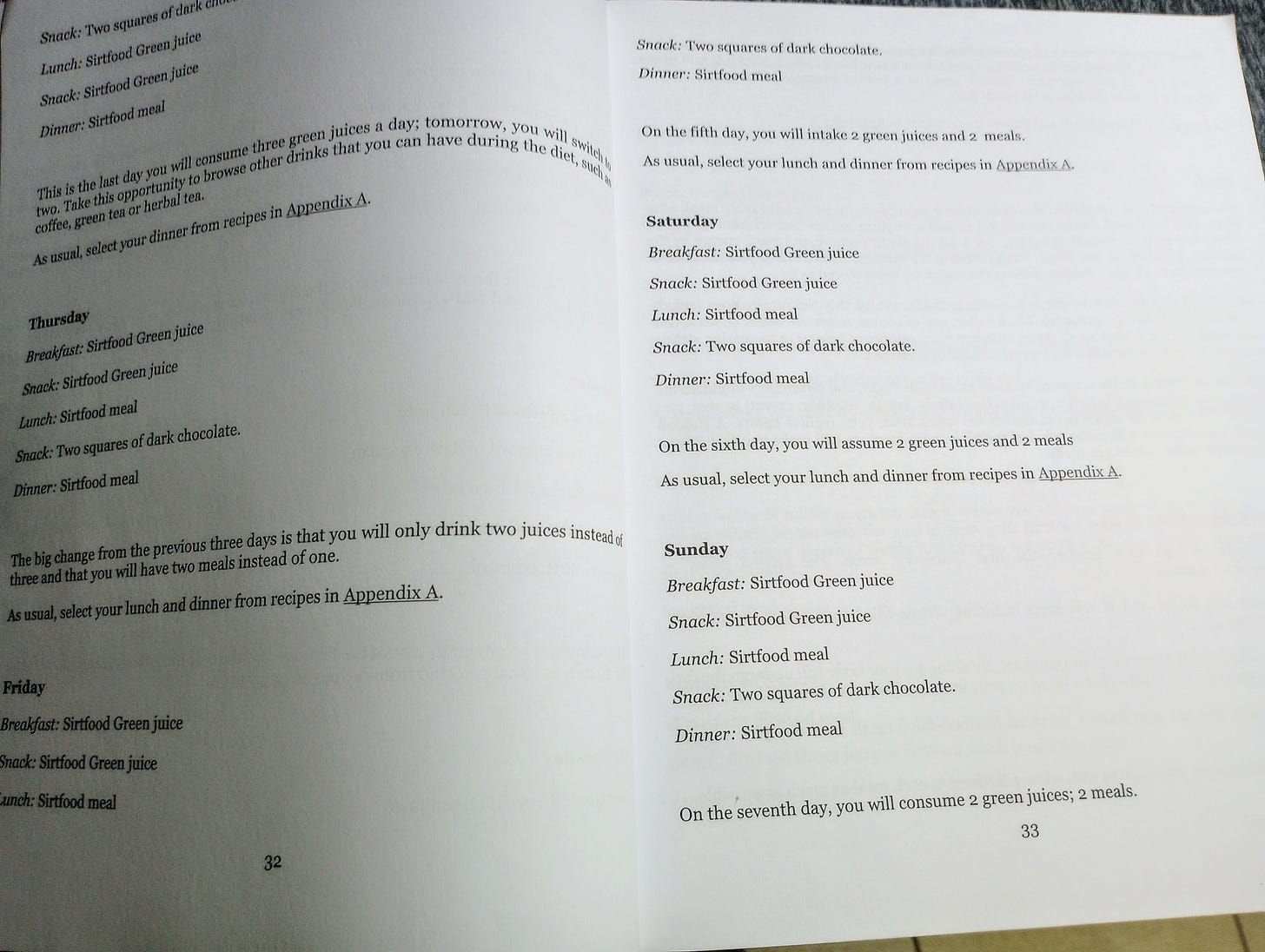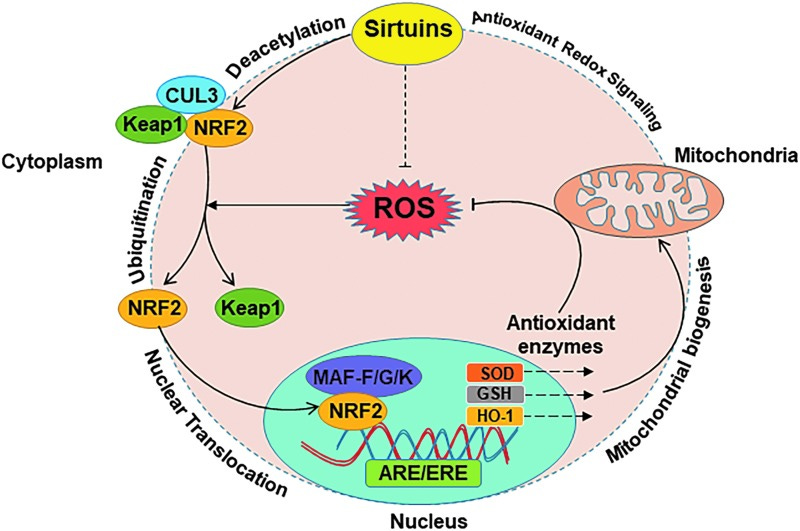SirtFood Diet -> is my Nrf2 promoting food diet basically.
Sirtuins are anti-aging by extending our telomere length, anti-inflammatory, and promoting them could help reverse chronic disease.
While browsing popular diet books, I came across a diet intended for weight loss, but it has anti-aging potential. I do not recommend this particular book*, but the concept is supportive of my Nrf2 promoting recommendations. *THIS IS NOT A GOOD BOOK, & THIS IS NOT A RECOMMENDATION TO BUY THIS BOOK. …And yet it reached #23 on Amazon in a diet book niche.
*This particular book seems like an AI type of job, (typos and odd errors), with information based on the 2016 Sirtfood Diet created by ‘celebrity nutritionists’ Aidan Goggins and Glen Matten (abebooks) which promotes eating foods that promote the sirtuin proteins. Foods rich in polyphenols can help promote the sirtuin group. Polyphenols also promote the enzyme lipase which helps us burn more fat. People following the diet lost 7 pounds on average in a study by Goggins/Matten. The focus of the SirtFood Diet is also on switching to low glycemic index foods and meals.

A popular diet (SirtFood Diet) may have led to a book/s which seem to be AI generated. The basic concept of the diet is helpful though and overlaps with my own recommendation for Nrf2 promoting foods. SIRT promotes Nrf2, so my research review for things that promote Nrf2, tend to do it by promoting SIRT genes. Nrf2 promoters, I found, also inhibit inflammatory NFkB pathways. The two proteins/genes are linked by sharing Circadian clock enzymes - like two shifts at a factory, the active NFkB is our daytime mode and the Nrf2 is a repair clean up crew for sleep/night time.
Modern life keeps us too much in the day time mode 100% of the time. Any lit alarm clock at night disrupts our circadian changes. Some genes are turned on every night and back on again in the morning with bright sunshine, while others it is the reverse, they will turn on during the pitch black night and turn off with bright lights.
We can prevent chronic inflammation and health damage by improving our light/dark environment. Reducing EMF by turning off the cellphones and WiFi at night also helps immensely. We are not supposed to be so overstimulated all the time. It floods cells with too much calcium which can over activate them to the point of cell death.
Polyphenol rich, colorful vegetables and fruits and fruit peels, can help switch genes to the beneficial on or off positions and literally turn down production of inflammatory proteins and increase production of helpful proteins. Pomegranate has been a focus of my research but lots of foods can help in similar ways and niacin (but not niacinamide/nicotinamide) and butyrate also would help.
The second half of this post looks at the science of how SIRT genes and the Nrf2 gene and protein are linked within our detox and repair systems.
Related posts - Nrf2 and NFkB - two proteins to know (denutrients.Substack)
Got Aging? ...Epigenetic methylation of DNA can be an indicator of aging & is worsened with higher weight/BMI. Advances in DNA Methylation Analysis: The New Frontier for Clinical Diagnostics - Personalized Lifestyle Medicine Institute (plminstitute.org) (denutrients.Substack)
Pomegranate Products for the Nociceptive Pain of Histamine Excess - graphical abstract. (denutrients.Substack)
Sirtuins are a group of proteins encoded by Silence Information Regulator genes (SIR). This group of proteins can turn on or off other genes, silencing or regulating genes. There are seven human sirtuins, called SIRT1-SIRT7, which are active in different areas or organs of the body. Weight control is impacted by SIRT3. Sirtuins help prevent aging of telomeres by promoting lengthening of them. SIRT1 helps with the inflammatory response associated with many age-related diseases. SIRT6 helps with DNA repair and reducing oxidative stress and inflammation.
The included sirtfoods, sirtuin promoting, used in the meal plans and recipes include the following foods and phytonutrients. The phytonutrients would overlap more - onions are rich in quercetin. These foods and phytonutrients overlap with my Nrf2 promoting/NfkB inhibiting list of foods. Pomegranate promotes SIRT3 as part of its benefits.
Red wine ~ resveratrol, coffee, kale, onions, soy ~ genistein, strawberries ~ ellagic acid, capers ~ quercetin, blueberries, red chicory, Medjool dates, parsley, Extra virgin olive oil, dark chocolate ~ flavonoids, polyphenols, Matcha green tea ~ catechins, turmeric, buckwheat, walnuts, arugula, chili peppers ~ capsaicin. …. eat only these foods and throw out or give away everything else you currently have…. not quite but close.
Other sirtuin promoting foods include: Apples, artichokes, asparagus, blackberries, blackcurrants, broad beans, broccoli, chestnuts, chia seeds, chickpeas, chicory, chives, corn, cranberries, dill, endive lettuce, ginger, goji berries, green beans, mint, oregano, Pak choi/Bok choy, peanuts, pistachios, plums, quinoa, raspberries, red grapes, sage, shallots, spinach, sunflower seeds, watercress, white onions.
While those are all Nrf2 promoting foods, too, they include some high oxalate choices - coffee, kale, blueberries, dark chocolate, green tea, buckwheat, walnuts. I don’t know if chicory or capers are high in oxalate. The diet book did not hold its value long. The hardcover is available used for $4-5. Handing someone a specific list of a few unusual foods can lead to an upset belly and abandoning their plan to lose weight or gain health. Becoming sicker and more inflamed will not help with weight loss. Severe diarrhea can cause weight loss that includes loss of muscle and health.
Sirtfood diet : 3 books in 1 : complete guide to burn fat activating your "Skinny Gene" + 200 tasty recipes cookbook for quick and easy meals + a smart 4 weeks meal plan to jumpstart your weight loss / Kate Hamilton. (Amazon) *Best selling author and this book apparently reached #27 on Amazon. **She has no website for her 12 books on the SirtFood Diet - it seems sketchy. Kate Hamilton is a popular name. There is a dietitian with that name but Amazon is the only location with info about “author dietitian” of the SirtFood books.
The recipes are not bad but tend towards being low in protein. Smoothies made in a high-powered blender are a main focus of the first week. Smoothie detox recipes tend to be low protein too, in this and other books I’ve seen. Entree servings of 14 grams, two-ounce meat equivalent or less usually with only a few at 21 gram / three ounce equivalent. If you are eating too little protein, then hunger and appetite won’t be satisfied and building muscle will be difficult. More muscle helps us lost weight be using more energy than fat tissue.
The protein content seems flatly wrong on many recipes. One cup.of chickpeas may have 14 grams of protein rather than 28.3 grams. Kale might have a smidge of protein but not much more than a gram or two.

An AI overview of protein content in kale is hugely variable - and quite inaccurate for some of the numbers - 2 cups of kale does not have 12 grams of protein.
The meal plan in the Sirtfood Diet, 3 books in 1, is kind of pathetic:

This book has quite a few typos and odd grammar or wording that makes the science incorrect or confusing. The 3 books in one! is also a little odd as there is an introduction in a few places and recipe sections in a few places. The page formatting tends towards basic pdf document stuck into a book.
Sirtuins work with niacin and NAD+ and with Nrf2
The following excerpts are confirming my pomegranate paper abstract as accurate. Niacin, butyrate, and pomegranate peel all help inhibit NFkb and promote anti-inflammatory pathways instead.

“Sirtuins (SIRTs 1–7) are a family of nicotinamide adenine dinucleotide (NAD)-dependent histone deacetylases with the ability to deacetylate histone and nonhistone targets. Recent studies show that sirtuins modulate the regulation of a variety of cellular processes associated with ARS [Antioxidant and Redox Signaling]. SIRT1, SIRT3, and SIRT5 protect the cell from ROS, and SIRT2, SIRT6, and SIRT7 modulate key oxidative stress genes and mechanisms. Interestingly, SIRT4 has been shown to induce ROS production and has antioxidative roles as well.” […]
“…the fact that their deacetylase activity is dependent on NAD+, a key redox signaling molecule, lends credence to the idea that sirtuins may be integral players in regulating cellular antioxidant and redox signaling (ARS) pathways. The coenzyme NAD+ mediates redox reactions by carrying electrons from one reaction to another (i.e., NAD+, as an oxidizing agent, accepts an electron and converts into its reduced form, NADH, and vice versa). During metabolic activity, reduced compounds (glucose and fatty acids) are oxidized, resulting in a release of energy. As part of β-oxidation, glycolysis, and the Krebs cycle, this energy is transmitted via NAD+ by reduction to NADH. The NAD+/NADH ratio is a key component of the redox state of a cell, which can indicate the status of the metabolism and health of cells (142).” (Singh, et al., 2018)
Nrf2 promoting foods are also sirtuin promoting, it seems. The food and phytonutrient list overlaps with mine, except mine has more foods. This is an alphabet soup of acronyms:
“The idea that sirtuins are involved in ARS also comes from their strong connections to several of the molecules of the antioxidant response element (ARE), which mediates signaling events involved in transcriptional regulation of gene expression in cells exposed to oxidative stress (Fig. 1). The ARE possesses biological and structural features that uniquely sense alteration of the cellular redox status and accordingly trigger transcriptional responses, mediated primarily by nuclear factor E2-related factor 2 (NRF2). NRF2 regulates the expression of several antioxidant and detoxification genes. NRF2 normally resides in the cytoplasm near Kelch like-ECH-associated protein 1 (KEAP1) and cullin 3 (CUL3), which degrade it by ubiquitination (76). Under oxidative stress, the KEAP1-CUL3 ubiquitination system is disrupted due to an interruption in critical cysteine residues of KEAP1. This allows NRF2 to translocate into the nucleus where it forms a heterodimer with one of the Maf proteins (MAFK, MAFG, MAFF) and binds to the ARE in the promoter region of antioxidative response genes resulting in initiation of their transcription (62, 114). Activation of NRF2 has also been shown to protect cells against cellular insults from electrophilic compounds. Once NRF2 is activated by electrophilic compounds, it translocates to the nucleus and binds to the electrophilic response element (ERE), which further modulates the expression of genes involved in the detoxication and elimination of electrophilic agents leading to enhancement in cellular antioxidant capacity (190). These ARE/ERE-controlled antioxidant enzymes and other antioxidants are important because, if left uncontrolled, oxidative stress can lead to various types of chronic conditions such as autoimmune, cardiovascular, and neurodegenerative diseases, cancer, aging, and acute ailments such as trauma and stroke (141).” (Singh, et al., 2018)

FIG. 1. Schematic representation showing interaction of sirtuins with NRF2 that regulates the expression of several antioxidant and detoxification genes. Under oxidative stress, the KEAP1-CUL3 ubiquitination system is disrupted, which allows NRF2 to translocate into the nucleus where it forms a heterodimer with one of the Maf proteins and binds to the ARE or ERE in the promoter region of antioxidative stress response genes resulting in mitochondrial biogenesis and antioxidant redox signaling. ARE, antioxidant response element; CUL3, cullin 3; ERE, electrophilic response element; GSH, glutathione; HO-1, heme oxygenase 1; KEAP1, kelch-like ECH-associated protein 1; NRF2, nuclear factor E2-related factor 2; ROS, reactive oxygen species; SOD, superoxide dismutase.
A more recent paper focused on CoV groups Nrf2 and Sirtuin activators as both potentially being helpful against COVID19.
“COVID-19 is a pandemic requiring immediate solution for treatment because of its complex pathophysiology. Exploration of novel targets and thus treatment will be life savers which is the need of the hour. 2 host factors- TMPRSS2 and ACE2 are responsible for the way the virus will enter and replicate in the host. Also NRF2 is an important protein responsible for its anti-inflammatory role by multiple mechanisms of action like inhibition of NF-kB, suppression of pro-inflammatory genes, etc. NRF2 is deacetylated by Sirtuins and therefore both have a direct association. Absence of SIRT indicates inhibition of NRF2 expression and thus no anti-oxidative and anti-inflammatory protection for the cell. Therefore, we propose that NRF2 activators and/or SIRT activators can be evaluated to check their efficacy in ameliorating the symptoms of COVID-19.” (Khan, et al., 2021)
It has to be niacin, not nicotinamide, which is downstream from niacin. Nicotinamide is more of the used-up form, oxidized form, rather than the from that is ready to help reduce inflammation. Nicotinamide may even increase oxidative stress by inhibiting SIRT1. See the graphic below, upper right corner - SIRT1 should inhibit P53 and promote NRF2
“Alternatively, the SIRT1 inhibitors sirtinol and nicotinamide were found to enhance H2O2-induced cell death (22, 60). Collectively, these data suggest that SIRT1 is a crucial player in the prevention of oxidative damage via a variety of mechanisms (Fig. 2).”
FIG. 2. “Mechanistic illustration of the sirtuins in ARS pathways. Sirtuins are involved in regulating ARS in numerous ways. SIRTs 1–7 have been found to be involved in modulating levels of ROS, antioxidant enzymes, DNA repair, mitochondrial dysfunction, and oxidative stress in the cell through key transcription factors such as NRF2, p53, NF-κB, FOXO, and PGC-1α. Question marks (?) indicate that exact mechanism is unknown. When cells become stressed, ROS production is increased, and coenzyme NAD+ (green diamond) activates various sirtuins (yellow ovals). In addition, sirtuins regulate the activity of the ARE (orange ovals), which in turn modulates the transcription of pro- and antioxidant genes to maintain redox signaling cascades. ADP, adenosine diphosphate; ARS, antioxidant and redox signaling; CAT, catalase; FOXO, class O of forkhead box transcription factors; G6PD, glucose 6-phosphate dehydrogenase; NAD, nicotinamide adenine dinucleotide; NF-κB, nuclear factor kappa B subunit; PARP1, poly (ADP-ribose) polymerase 1; PGAM2, phosphoglycerate mutase; SIRT, sirtuin.” (Khan, et al., 2021)
“cellular antioxidant and redox signaling (ARS) pathways” (Khan, et al., 2021)
“The idea that sirtuins are involved in ARS also comes from their strong connections to several of the molecules of the antioxidant response element (ARE), which mediates signaling events involved in transcriptional regulation of gene expression in cells exposed to oxidative stress (Fig. 1). The ARE possesses biological and structural features that uniquely sense alteration of the cellular redox status and accordingly trigger transcriptional responses, mediated primarily by nuclear factor E2-related factor 2 (NRF2).” (Khan, et al., 2021)
….It seems to be true that ‘anyone’ can become a bestselling Amazon author. Gavin Mounsey reviewed a similar poorly formatted “3 in 1” book that seemed like no real author existed.
I really do need finish writing a book. Apparently, it is easy to be a ‘celebrity nutritionist’ author.
Disclaimer: This information is being provided for educational purposes within the guidelines of Fair Use and is not intended to provide individual health care guidance.
Reference List
(Khan, et al., 2021) Khan H, Patel S, Majumdar A. Role of NRF2 and Sirtuin activators in COVID-19. Clin Immunol. 2021 Dec;233:108879. doi: 10.1016/j.clim.2021.108879. Epub 2021 Nov 16. PMID: 34798239; PMCID: PMC8592856. https://www.ncbi.nlm.nih.gov/pmc/articles/PMC8592856/
(Singh, et al., 2018) Singh CK, Chhabra G, Ndiaye MA, Garcia-Peterson LM, Mack NJ, Ahmad N. The Role of Sirtuins in Antioxidant and Redox Signaling. Antioxid Redox Signal. 2018 Mar 10;28(8):643-661. doi: 10.1089/ars.2017.7290. Epub 2017 Oct 20. PMID: 28891317; PMCID: PMC5824489. https://www.ncbi.nlm.nih.gov/pmc/articles/PMC5824489/







Wow! Great research in an easy to read format. Many thanks.
JD - A opus to Nrf2, a paradoxical protein which is a 2 edged sword, in that it is both a tumor suppressor, and an oncogene.